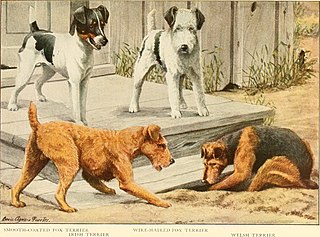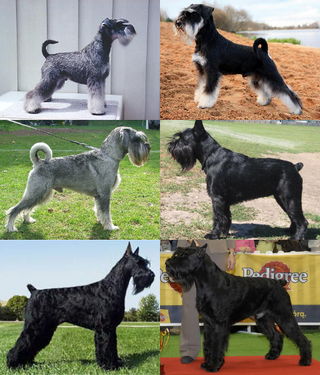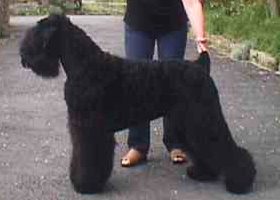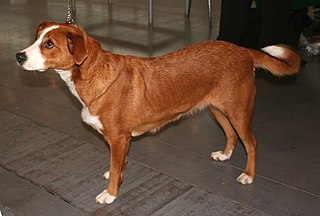
The Pinscher is a group of German dog breeds, developed originally as ratters on farms or as guard dogs. In the twenty-first century they are commonly kept as companion animals.

The Pinscher is a group of German dog breeds, developed originally as ratters on farms or as guard dogs. In the twenty-first century they are commonly kept as companion animals.
It is considered that the German Pinscher is a prototypical Pinscher and one of the oldest German breeds, more closely related to the Standard Schnauzer (once known as the Wire-Haired Pinscher) than the Dobermann and other Pinschers. [1] Since the mid-19th century, breeders stopped crossbreeding these coat types, and with the formation of the German Pinscher-Schnauzer-Club (PSK) in 1895, advanced them to distinct breed varieties. [2]
There are several theories on the etymology of the word Pinscher; that it derives from French "pincer", meaning "to seize" and "to nip", [1] or "to bite" and "to grip" which are possibly related to their function of catching vermin on the farm, [3] that it derives from English "pinch" referring to their clipped ears, [4] "fox terrier" type of dog (considered that it was a descriptive term meaning "settler" or "terrier" dog method of working, and not heritage [2] ), [5] or biter,[ citation needed ] although the verb "pinch" has the same early 13th century Old North French *pinchier derivation, which itself possibly originates from Vulgar Latin. [6]
The Fédération Cynologique Internationale recognizes the following pinscher breeds in Group 2, Section 1: Pinschers and Schnauzers, Section 1.1 Pinscher: [7]
Provisional:
There may be other related hunting dogs called pinscher that are not recognized breeds. In addition, individual breeders often attempt the creation of new breeds which they may call pinschers. One example of these is the Carlin Pinscher, which has been developed by crossing the Pug with the Miniature Pinscher, or other similar breeds. There are a very large number of sporting clubs, breed clubs, and internet-based breed registries and businesses in which dogs may be registered under whatever name the owner or seller wishes. [9]

Terrier is a type of dog originally bred to hunt vermin. A terrier is a dog of any one of many breeds or landraces of the terrier type, which are typically small, wiry, game, and fearless. Terrier breeds vary greatly in size from just 1 kg (2 lb) to over 60 kg and are usually categorized by size or function. There are five different groups of terrier, with each group having different shapes and sizes.

The Affenpinscher, also known as the Monkey Terrier, is a small-sized terrier-like toy Pinscher breed of dog that originated in Germany. With a distinctive appearance and charming personality, the Affenpinscher has gained popularity among dog lovers worldwide.

The Fédération cynologique internationale (FCI) is the largest international federation of national kennel clubs and purebred registries. The FCI is based in Thuin, Belgium and has 98 members and contract partners.

The Miniature Schnauzer is a breed of small dog of the Schnauzer type that originated in Germany in the mid-to-late 19th century. Miniature Schnauzers may have been developed from the smallest specimens of the Standard Schnauzer, or crosses between the standard and one or more smaller breeds such as the Affenpinscher, Miniature Pinscher, and Poodles, as farmers bred a small dog that was an efficient ratting dog. They are described as "spunky" but aloof dogs, with good guarding tendencies without some guard dogs' predisposition to bite. Miniature Schnauzers are recognized in four colors internationally: solid black, black and silver, salt and pepper, and white.

The Toy Manchester Terrier is a breed of dog, categorized as a terrier. The breed was bred down in size in North America from the Manchester Terrier, and is placed in the Toy Group by the American Kennel Club and the Canadian Kennel Club. Neither the Fédération Cynologique Internationale nor The Kennel Club recognize a Toy variety of the Manchester Terrier.
Toy dog traditionally refers to a very small dog or a grouping of small and very small breeds of dog. A toy dog may be of any of various dog types. Types of dogs referred to as toy dogs may include spaniels, pinschers and terriers that have been bred down in size. Not all toy dogs are lap dogs.

A Schnauzer is a dog breed type that originated in Germany from the 14th to 16th centuries. The term comes from the German word for "snout" and means colloquially "moustache", or "whiskered snout", because of the dog's distinctively bearded snout. Initially it was called Wire-Haired Pinscher, while Schnauzer was adopted in 1879.

The Miniature Pinscher, also known as the Zwergpinscher and Mini Pin, is a small breed of dog of the pinscher type originating in Germany. While the breed's visual similarities to the Toy Manchester Terrier, which somewhat resembles the Pinscher breeds, remain a matter of controversy, genetic research has shown that the two breeds have shared, unique ancestry. The ancestors of the Toy Manchester and Miniature Pinscher may have become geographically separated many centuries ago and retained similarities simply through breeding selection for the same traits; nevertheless, the 2017 research also showed that the two breeds remain more closely related to each other than to other breeds. The breed's ancestors may also include the German Pinscher, Italian greyhounds and dachshunds. The Miniature Pinscher's known origins are in Germany, where it was often referred to as the Zwerg Pinscher in historical documents. German Kennel Club documents also refer to the Miniature Pinscher as the "reh" Pinscher, but this term is only used for a dog of stag-red color, "reh" referring to a small red deer formerly found in German forests. The Miniature Pinscher originated several centuries ago as an efficient barnyard ratter.

The Lhasa Apso is a non-sporting dog breed originating in Tibet. It has traditionally been used as an interior sentinel.

The Black Russian Terrier, also known as the Chornyi Terrier, is a breed of dog created in USSR in Red Star Kennel during the late 1940s and the early 1950s for use as military/working dogs. At the present time, the Black Russian Terrier is a breed recognized by the FCI, AKC, CKC, KC, ANKC, NZKC and other cynological organizations. The contemporary Black Russian Terrier is a working dog, guarding dog, sporting and companion dog.

The Schnauzer or Mittelschnauzer is a German breed of dog in the Pinscher and Schnauzer group. It is characterised by an abundant bristly beard and whiskers, usually lighter than the coat. It is one of three Schnauzer breeds, the others being the Giant Schnauzer or Riesenschnauzer, and the Miniature Schnauzer or Zwergschnauzer. In Germany it is an endangered breed, and is listed in category III of the Rote Liste of the Gesellschaft zur Erhaltung alter und gefährdeter Haustierrassen.

The Giant Schnauzer is a breed of dog developed in the 17th century in Germany. It is the largest of the three breeds of Schnauzer—the other two breeds being the Standard Schnauzer and the Miniature Schnauzer. Numerous breeds were used in its development, including the black Great Dane, the Bouvier des Flandres, and the German Pinscher. Originally bred to assist on farms by driving livestock to market and guarding the farmer's property, the breed eventually moved into the city, where it worked guarding breweries, butchers' shops, stockyards and factories. It was unknown outside of Bavaria until it became popular as a military dog during World War I and World War II.

The Dobermann, or Doberman Pinscher in the U.S. and Canada, is a medium-large breed of domestic dog that was originally developed around 1890 by Louis Dobermann, a tax collector from Germany. The Dobermann has a long muzzle. It stands on its pads and is not usually heavy-footed. Ideally, they have an even and graceful gait. Traditionally, the ears are cropped and posted and the tail is docked. However, in some countries, these procedures are now illegal and it is often considered cruel and unnecessary. Dobermanns have markings on the chest, paws/legs, muzzle, above the eyes, and underneath the tail.

The German Pinscher or Deutscher Pinscher is a German breed of terrier in the Pinscher and Schnauzer group. It shares common origins with the Schnauzer, of which it is essentially a short-haired equivalent. It is seen in two colours, either black-and-tan or self-coloured red, this varying from deer-red to a dark reddish brown.

Danish–Swedish farmdog is a breed of dog that has its origin in Denmark and southern Sweden, but has become popular all over Scandinavia. It is a native breed which has historically lived on farms in the eastern part of Denmark and southernmost part of Sweden, serving as a guard dog, rat catcher and hunting dog. The breed's soft and gentle temperament also makes them excellent companion dogs. There are some indications that the breed originates from the pinscher breeds and the British white hunting terriers.

The Austrian Pinscher is a medium-sized breed of pinscher-type dog from Austria, where dogs of the type were originally farm dogs, keeping barns free of rats and acting as home guards, livestock guardians, and drovers. The name originally given to the breed in 1928 was the Österreichischer Kurzhaarpinscher to differentiate it from similarly named breeds, but today in its country of origin the breed is officially called the Österreichischer Pinscher, or Austrian Pinscher in English.

The Dutch Smoushond is a small breed of dog, related to the Pinscher and Schnauzer breed type kept in stables to eliminate rats and mice in Germany and the Netherlands. It is very rare and not well known outside the Netherlands, its country of origin.
The Kennel Club of India is a registry of purebred dogs in India. As well as maintaining a registry of pedigrees, the club promotes and sanctions events for purebred dogs, including annual dog shows and specialty shows. The Kennel Club of India is a member of the Fédération Cynologique Internationale.
Ch. Ferry v. Rauhfelsen of Giralda also known as Ferry, a Doberman Pinscher, best known for being Best in Show at the Westminster Kennel Club Dog Show in both 1939 while owned by Geraldine Rockefeller Dodge. He was the grandfather of two-time champion, Rancho Dobe's Storm.
A ratter is any dog used for catching and killing rats and similar vermin. Specialised rat-catching breeds are found in many countries. A typical ratter is small to medium-sized and has a short and smooth coat.
The German Pinscher is among its homeland's oldest breeds. As the progenitor of the Miniature Pinscher and the ever-popular Doberman, among other German breeds, it can be said to be the prototypical pinscher. (A helpful historian tells us that " 'pinscher' appears to be a Germanic form of the French word 'pincer,' meaning "to seize" or "to nip".) And seizing and nipping are apt descriptions of how GPs originally earned a living: rat killing...The German Pinscher originated in Germany and is more closely associated to the Schnauzer than the Doberman and other Pinschers.
Part of the confusion in origin comes from the word "pinscher", which is a descriptive term like "settler" or "terrier" that denotes the dog's method of working, not his heritage. "Pinscher" refers to a dog's habit of jumping on, and fiercely biting its quarry. A definition in Henne's Dictionary of the German Language indicates that Pinscher is "borrowed from the English word pincher, meaning one who pinches, nips or tweaks."
The word pinscher means 'to bite' or 'to grip' and it was used to describe the breed's original function as a killer of rats and other vermin.